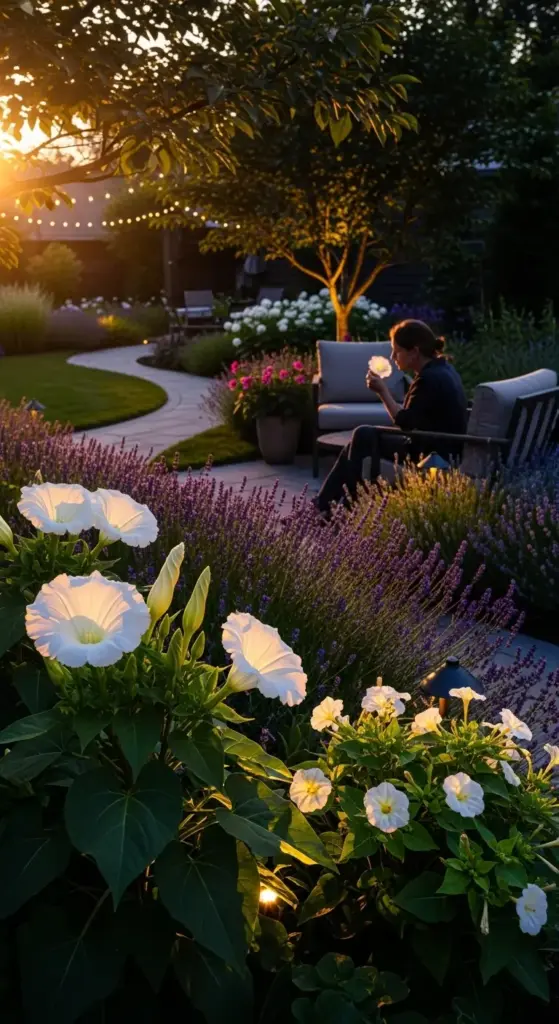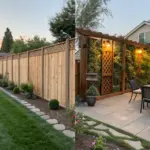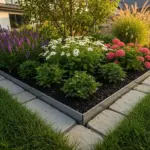5. Fragrant Evening Moon Garden

The first time I sat in my garden at 9 PM and actually enjoyed it was a total accident. I’d been watering late after a busy day and suddenly noticed this incredible sweet fragrance I’d never smelled before.
Turns out, some of the best garden magic happens after dark.
Night-Blooming Flowers That Transform Your Evening
Evening gardens are completely different beasts than daytime displays. I spent two years wondering why my regular flower garden felt dead at night before discovering night-blooming plants.
Four o’clocks are absolute game-changers – they literally open as the sun goes down and release this amazing sweet fragrance. I planted a dozen and now my whole patio smells incredible every evening.
Evening primrose opens with an audible pop right at dusk. It sounds crazy, but you can actually hear the flowers opening if you’re sitting quietly nearby.
Moonflowers are like morning glories’ nocturnal cousins. These huge white trumpet flowers unfurl in minutes once darkness hits. Watching them open is better than TV.
Night-blooming cereus only blooms once a year, but it’s absolutely spectacular. The flowers are massive and fragrant, and the whole neighborhood comes over to watch when mine blooms.
Nicotiana (flowering tobacco) releases its fragrance at night to attract moths. The white varieties glow in moonlight and smell like heaven.
Strategic Lighting That Actually Enhances Natural Beauty
Garden lighting can make or break your moon garden experience. I learned this after installing bright floodlights that completely killed the magical nighttime atmosphere.
Uplighting white and pale flowers creates dramatic shadows and makes blooms glow like they’re lit from within. I use small LED spotlights positioned at ground level.
Path lighting should be subtle – just enough to navigate safely without destroying night vision. Solar stake lights work perfectly and don’t require wiring.
String lights add romance but can look tacky if overdone. I use warm white LEDs strung through tree branches about 8 feet high.
Candle lanterns provide flickering light that enhances fragrance perception. The gentle movement draws attention to night-blooming flowers without overwhelming them.
The goal is enhancing what’s already beautiful, not competing with it.
Creating Cozy Evening Seating Areas
My first attempt at nighttime garden seating was just dragging a chair outside. Big mistake – comfort matters way more in the evening when you’re trying to relax.
Weather-resistant furniture is essential since evening gardens get dewy. I learned this after ruining two sets of regular patio cushions in one season.
Strategic placement near fragrant plants maximizes the sensory experience. My favorite spot is downwind from my jasmine vine – the scent is incredible on summer evenings.
Blanket storage in weatherproof containers means you can stay outside longer as temperatures drop. I keep a cedar chest filled with outdoor throws near my seating area.
Side tables for drinks and books make evening garden time more comfortable. I use teak stools that double as extra seating when friends come over.
Wind protection from screens or plantings keeps candles lit and makes seating areas more comfortable. My bamboo screen blocks wind but doesn’t obstruct garden views.
Aromatic Herbs and Foliage Combinations
Fragrant companion planting multiplies the sensory impact of your evening garden. I discovered this by accident when I brushed against my lavender while deadheading nearby flowers.
Lavender releases fragrance when touched and looks gorgeous in moonlight. I planted it along pathways so you brush against it naturally while walking.
Rosemary provides year-round fragrance and structure. The needle-like foliage catches dew beautifully and releases scent when the evening breeze hits it.
Mint varieties like chocolate mint and pineapple mint add unexpected fragrance layers. I plant them in containers to prevent spreading.
Scented geraniums come in amazing fragrances like rose, lemon, and even chocolate. Their fuzzy leaves hold scent well and release it with the slightest touch.
Night-scented stock is specifically bred for evening fragrance. It looks unremarkable during the day but becomes incredibly fragrant after sunset.
Evening Garden Maintenance Strategies
Nighttime garden care requires different timing and techniques than regular gardening. I had to completely adjust my maintenance schedule.
Evening watering works better for night gardens since many fragrant plants prefer consistent moisture. I water around 6 PM so plants are well-hydrated for their evening show.
Deadheading night-blooming flowers happens in early morning before they close. Four o’clocks and moonflowers need daily attention during peak season.
Pest control is trickier since many beneficial insects are active at night. I hand-pick pests in early evening before the good bugs come out.
Fertilizing night-blooming plants requires extra phosphorus for flower production. I use bloom booster fertilizer every two weeks during growing season.
Pruning aromatic herbs regularly keeps them producing fresh, fragrant growth. I harvest herbs for cooking while maintaining plant shape.
Romantic Design Elements for Special Occasions
My evening garden has become the go-to spot for romantic dinners and special celebrations. The right design elements make ordinary evenings feel magical.
Water features sound amazing at night when other noises quiet down. My small fountain creates gentle background sound that’s incredibly relaxing.
Pergolas or arbors provide structure for climbing fragrant vines. My jasmine-covered pergola creates a natural ceiling that holds fragrance beautifully.
Fire features extend the season and create focal points for gatherings. I use a small fire bowl that provides warmth without overwhelming the space.
Outdoor curtains in white or cream fabric flutter in evening breezes and look ethereal in garden lighting. They also provide privacy for intimate gatherings.
Vintage garden furniture painted white or cream fits the moon garden aesthetic perfectly. I found mine at estate sales and restored them myself.
Seasonal Fragrance Planning
Year-round evening interest requires careful plant selection and timing. My garden now offers different fragrances throughout the growing season.
Spring starts with sweet alyssum and stock for cool-weather fragrance. These handle light frosts and bloom when most other plants are just emerging.
Early summer brings jasmine and honeysuckle into peak fragrance. This is when my garden smells the most incredible – almost overwhelming on still evenings.
Mid-summer features tuberose and night-blooming cereus. Tuberose is probably the most intensely fragrant flower I’ve ever grown.
Late summer adds night-scented stock and late-blooming nicotiana. These extend the fragrant season when many spring bloomers are fading.
Fall relies on autumn clematis and late-blooming jasmine varieties. The cooler air actually intensifies fragrance perception.
Common Evening Garden Mistakes
Over-lighting ruins the intimate atmosphere that makes evening gardens special. I learned to use way less light than I thought I needed.
Wrong plant placement puts fragrant plants where you can’t enjoy them. I moved my most fragrant plants closer to seating areas after realizing I was missing half the experience.
Ignoring wind patterns means fragrance blows away from where you sit. I spent a whole season wondering why I couldn’t smell my jasmine until I realized it was upwind from my chair.
Daytime-focused maintenance misses the peak performance times of evening plants. I had to shift my garden schedule to match when these plants actually shine.
Seasonal neglect happens when you don’t plan for year-round evening interest. My first moon garden was amazing in July but boring the rest of the year.
Creating Multi-Sensory Evening Experiences
Evening gardens engage all your senses in ways daytime gardens can’t match. The combination of fragrance, gentle sounds, and soft lighting creates something truly magical.
Texture plants like lamb’s ear and dusty miller look silvery in moonlight and feel amazing to touch. I plant them where people naturally reach while walking.
Sound elements from rustling grasses or bamboo add another sensory layer. My ornamental grasses whisper in evening breezes.
Temperature contrast from cool stone paths and warm wooden benches adds physical interest to evening garden walks.
The best part about moon gardens? They force you to slow down and actually experience your outdoor space. You can’t rush through an evening garden – the whole point is lingering and enjoying the sensory experience.
My evening garden has become my favorite room in the house. It’s where I decompress after stressful days and where we host our most memorable dinner parties.
Ready to combine beauty with function in the most delicious way possible? Click “next” to discover how edible flower kitchen gardens can transform your cooking while creating stunning garden displays! 🌺









GIPHY App Key not set. Please check settings